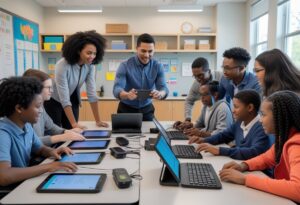5 Ways Smart Glasses Empower Inclusive Teaching

Empowering Inclusive Education with Smart Glasses
Empowering educators to create inclusive environments is essential in today’s diverse classrooms. As the leading assistive technology provider, we at New England Low Vision and Blindness are dedicated to equipping Teachers of the Visually Impaired with the tools they need to foster an equitable learning experience. Smart glasses have emerged as a profound tool in this mission, enabling students with visual impairments to participate more fully in their education.
The rapid development of smart glasses technology offers exciting possibilities for enhancing inclusivity. By integrating visual aids like eSight glasses, educators can tailor their teaching methods to meet individual needs, providing real-time support that enhances both learning and confidence. This innovative approach not only improves educational access but also promotes independence and engagement in the classroom.
Our commitment goes beyond just providing technology; we seek to inspire and support teachers by offering training and resources that transform educational practices. By embracing leading-edge tools like smart glasses, educators have the opportunity to redefine what is possible in inclusive education, enabling all students to thrive.
Inclusive Teaching and the Role of Smart Glasses
Smart glasses offer transformative possibilities for inclusive classrooms, enabling tailored learning experiences for students with diverse needs. By integrating these technologies, educators can ensure all students, including those with visual impairments, participate actively and equitably in their education.
The Concept of Inclusive Classrooms
Inclusive classrooms strive to accommodate diverse learning needs, fostering an environment where every student can succeed. For students with visual impairments, this means utilizing tools and resources that address their specific challenges. An inclusive educational setting allows students to access learning materials in formats that suit their needs, enhancing engagement and understanding.
Teachers of the Visually Impaired (TVIs) play a crucial role in adapting curricula and resources. Ensuring that all students have equal opportunities to learn requires a collaborative approach where teachers, aides, and students work together. Our goal is to bring hope and practical solutions that make a real difference in learners’ experiences.
Smart Glasses as a Tool for Inclusive Education
Smart glasses represent a leading-edge tool in assistive technology, revolutionizing how students with visual impairments engage in classroom activities. These devices allow for real-time text-to-speech conversion, enabling users to access printed text more easily. Such functionality can be especially beneficial in enhancing the classroom experience.
Moreover, smart glasses can facilitate discreet communication and personalized learning opportunities. For instance, a student might use them to quietly message a teacher during a lesson, encouraging participation without undue attention. As providers of assistive technology, we see these tools as vital for empowering students and supporting inclusive education goals.
Improving Classroom Engagement with Smart Glasses
Smart glasses present innovative opportunities to enhance student engagement in the classroom. They can transform traditional teaching methods into more interactive and participative experiences. By promoting active participation, supporting personalized learning and feedback, and facilitating collaborative work, educators can create a more inclusive and engaging learning environment.
Promoting Active Participation
Smart glasses empower students by offering a dynamic and interactive learning experience. With features such as real-time information displays and interactive lessons, students can engage more deeply with educational content. This technology can captivate students’ attention, encouraging them to participate actively during lessons.
Students with visual impairments particularly benefit as smart glasses adapt visual content to be more accessible. By overlaying information in the real world, these devices enhance comprehension and engagement. Educators can leverage smart glasses to incorporate gamified elements or multimedia content, which can make learning more captivating.
Supporting Personalized Learning and Feedback
Personalized learning is significantly enhanced through the use of smart glasses. These devices can tailor educational content to meet the individual needs of each student, providing a customized learning pathway. For students with varying abilities, including those who are visually impaired, smart glasses can adjust the complexity of information based on the users’ progress and comprehension level.
The real-time feedback capabilities allow educators to offer instant, individualized comments and suggestions. By utilizing data collected from the glasses, teachers can understand student difficulties and adapt their teaching methods accordingly. This personalized approach ensures that all students, regardless of their unique learning requirements, receive the support they need.
Facilitating Collaborative Work
Collaboration is a critical component of modern education, and smart glasses are poised to enhance this aspect. These devices enable students to work together in a more connected and interactive way, sharing information and insights directly through the glasses.
The ability to view shared content and communicate seamlessly, regardless of location, fosters a sense of community and teamwork. Educators can design group projects where students must collaborate using augmented reality features, helping to develop essential interpersonal skills. As an assistive technology provider, New England Low Vision and Blindness emphasizes the importance of tools that nurture inclusivity and cooperation, essential for empowering students of all abilities.
Designing Inclusive Learning Experiences
Incorporating inclusive design into educational practices benefits students by ensuring equitable access and participation. By applying principles like Universal Design for Learning and creating supportive and nurturing classroom settings, we can set high expectations and encourage all students to achieve their potential.
Applying Universal Design for Learning Principles
We understand the importance of Universal Design for Learning (UDL) in fostering inclusive learning. This framework is centered on offering multiple means of engagement, representation, and expression. By implementing UDL, teachers can tailor their methods to cater to diverse learning styles. This approach allows lessons to be accessible to all students, including those who are visually impaired. Key strategies include using auditory materials and tactile resources.
Incorporating technology such as smart glasses can enhance accessibility. These devices, supplied by us at New England Low Vision and Blindness, aid visual and auditory learners by providing real-time assistance. Educators must be versatile and innovative in employing these tools to create a comprehensive learning environment that embraces diversity.
Creating a Safe and Nurturing Classroom Environment
A safe and nurturing classroom is paramount to inclusive education. It is essential that students feel supported both emotionally and physically. We advocate for classroom environments where students can express themselves openly without fear of judgment. Teachers can facilitate this by fostering open communication and promoting respect among students.
Our role in supplying leading-edge assistive technology plays a crucial part in shaping such environments. Ensuring that all students have access to the necessary tools reinforces inclusivity and allows them to participate fully in the learning process. An empathetic approach, combined with technology, helps build an atmosphere where every student can thrive.
Setting High Expectations for Every Student
Setting high expectations is critical in empowering students to reach their full potential. It is important to communicate confidence in every student’s ability while providing the necessary support to help them achieve their goals. We believe that all students, regardless of their visual impairments, can excel academically and socially when given the right opportunities and encouragement.
Educators can nurture self-confidence in their students by recognizing strengths and providing individualized feedback. By leveraging technologies and resources we offer, such as screen readers and magnification aids, we can help teachers support their students in meeting, and even exceeding, those high expectations. This approach not only promotes academic success but also encourages personal growth and self-belief.
Addressing Challenges in Inclusive Education
In the realm of inclusive education, successfully empowering every student requires addressing significant challenges. Through innovative approaches like differentiated instruction and the integration of smart glasses, we enable all students to actively engage and succeed.
Overcoming Barriers to Student Success
Students face a variety of challenges in achieving academic success, especially in inclusive settings. Teachers need to adopt strategies that address these barriers. For visually impaired students, this may include providing access to assistive technology that allows them to engage fully with the curriculum.
We believe that by incorporating adaptive tools, teachers can create environments where students learn without feeling marginalized. Offering additional support through personalized educational resources can help align their unique learning paths with their peers. Confidence and independence grow when students feel they have the necessary tools to succeed academically.
Differentiated Instruction with Smart Glasses
Smart glasses offer a powerful way to implement differentiated instruction that meets diverse learning needs. By integrating leading-edge technology, these devices can provide visual, auditory, and tactile input tailored to each student’s strengths. This approach allows educators to personalize learning experiences while maintaining a cohesive classroom dynamic.
We utilize smart glasses to deliver real-time text-to-speech conversion or magnification features that make learning accessible for visually impaired students. With functionalities that adjust to individual preferences, smart glasses enable a more immersive and inclusive educational experience. Teachers can thus manage their classroom more effectively, knowing each student has the tools to thrive.
Cultivating a Sense of Belonging Through Technology
Technology plays a crucial role in fostering a sense of belonging and inclusivity in the classroom. By enabling enhanced communication and providing tools that facilitate inclusive learning, we can create supportive environments for students with visual impairments.
Building an Inclusive Classroom Community
Creating an inclusive classroom community requires the intentional use of technology. Tools such as smart glasses help us design spaces where every student feels valued and connected. These devices can bridge gaps in traditional learning setups by offering personalized visual and auditory support, enabling all students to participate fully.
Smart glasses can transcribe spoken words to text, ensuring that students can follow lessons at their own pace. By integrating voice commands and feedback, they can facilitate interactive learning experiences. This encourages collaboration and active participation, key components in building community and a robust sense of belonging.
Enhancing Expression and Communication
Smart glasses enhance expression and communication by providing assistive features that empower students with visual impairments to convey their ideas effectively. Equipped with capabilities such as text-to-speech and visual recognition, these devices allow for richer interaction within the classroom.
Through these technologies, students can explore and express their creativity and ideas without being hindered by traditional barriers. Speech-to-text features support written expression, making it easier for students to compose essays or presentations. This empowers students to communicate more freely and feel heard, integral to their educational development and sense of belonging.
By integrating these technologies into the classroom, we at New England Low Vision and Blindness aim to bring hope and transform learning experiences for students with visual impairments.
Frequently Asked Questions
Smart glasses are transforming the educational landscape by supporting inclusive teaching practices. They offer unique benefits for students with disabilities, improve engagement, and integrate seamlessly with other technologies.
How do smart glasses enhance learning experiences for students with disabilities?
Smart glasses like eSight are designed to help students with visual impairments fully participate in the classroom. These devices provide visual aids that improve accessibility and empower students by enabling them to see clearer details, which enhances learning experiences for those with low vision or blindness.
What teaching methods are improved by using smart glasses in the classroom?
Smart glasses aid in hands-free interaction with technology, which supports methods like active learning and real-time feedback. Teachers can use augmented reality to offer interactive lessons, and students can receive personalized instructions that align with their specific needs and learning styles.
In what ways do smart glasses contribute to a more engaging learning environment?
By integrating augmented reality, smart glasses offer immersive experiences that capture student interest and make lessons more dynamic. With features that allow for interactive simulations or visual storytelling, these devices enable a more engaging and participatory classroom setting.
Can smart glasses be integrated with other educational technologies, and if so, how?
Yes, smart glasses can be integrated with learning management systems and educational apps, enhancing collaborative learning experiences. They can work alongside tablets, laptops, and interactive whiteboards to provide a cohesive learning platform, enriching the resources available in inclusive educational environments.
What training do teachers need to effectively use smart glasses in their instruction?
Teachers benefit from training that covers the setup, functionality, and pedagogical applications of smart glasses. Familiarity with the device’s software and integration techniques ensures that educators can maximize the technology’s benefits in the classroom, enabling them to tailor lessons to each student’s needs. (Learn more about our Training Services for Educators)
How do smart glasses support personalized learning in an inclusive educational setting?
Smart glasses offer personalized content and real-time data collection, which helps tailor educational experiences to individual learning preferences. They allow teachers to create adaptive learning pathways, addressing diverse needs and promoting a more inclusive approach to education.
Ray-Ban Meta Smart Glasses Training Services
Unlock the Full Potential of Ray-Ban Meta Smart Glasses
Maximize the benefits of Ray-Ban Meta Smart Glasses with our expert, personalized training. Our hands-on guidance will help you set up, customize, and fully utilize the technology to enhance your daily routine.
Training Includes:
- Device Setup & Customization
- Voice Commands & Gesture Controls
- App & Smart Device Integration
- Accessibility Features
- Practical Everyday Use



